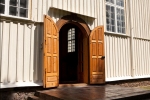November 2011
Mission: The Church's Heartbeat
Welcome Neighbor
The Rev. John Sewak Ray remembers when he and the members of his parish first met Paw Htoo, a Burmese Karen refugee they welcomed to the United States a few years back.
The woman was getting off a plane in Atlanta with her three young girls, where she was to resettle with assistance from Refugee Resettlement and Immigration Services of Atlanta (RRISA), a local affiliate of Episcopal Migration Ministries.
“They had travelled from Bangkok to Tokyo to Chicago to Atlanta, all in one go,” Ray said. “Imagine our shock when she got off the plane with only one plastic bag. We thought there must be luggage, but that was all they had.”
Ray and the members of Christ the King Episcopal Church in Lilburn, Georgia assisted the family for a period of several months after they arrived, providing a furnished apartment, food, English tutoring, transportation to appointments, friendship, and a sympathetic ear.
It was an undertaking laden with a number of challenges; Paw Htoo spoke no English and had lost her husband while living in a refugee camp in Thailand. She was also arriving during a tough economic period and would have to quickly adjust and find work to support her three daughters. The members of Christ the King had to work hard to help her meet all of these challenges.
Still, Ray said that Christ the King, a new parish with limited financial resources and a diverse, multi-ethnic membership, benefitted greatly from the experience of welcoming Paw Thoo and her family.
“When it comes to our sense of God’s mission in the world, we can very often talk about these things in the abstract. ‘That’s a good Gospel lesson or that’s a good sermon,’ but how does it work out in practice?” Ray said. “Many churches go on mission trips, but we were not in a position to do that. Here was something that we were able to do that was a tremendously enriching and eye-opening experience.”
“Members were working with each other and getting to know each other. We grew in our sense of unity, of oneness, and in our understanding of God’s mission in the world. I think that will always be a part of the DNA of our congregation: we’ll always be mission oriented, and it started with Paw Htoo and her girls.”
Who are Refugees?
Refugees travel from their home countries to seek a better, safer life abroad. But refugees are distinct from other immigrants in a number of ways, most significantly in that they are fleeing their homes because they’ve experienced or have been threatened with persecution on account of race, religion, ethnicity, political views, or social identity.
Many refugees, like the family that Ray and his church assisted, spend years or decades in refugee camps, and the physical, mental, and emotional scars of violence, torture and harassment are a burden that some will carry their entire lives.
Only a small percentage of refugees find a permanent home through resettlement to a third country. In the U.S., that resettlement is managed by the Department of State and the Department of Health and Human Services in partnership with service providers like Episcopal Migration Ministries and its local offices, which welcome up to 5,000 newcomers in a given year.
The Role of Churches
Episcopal churches in the U.S. have been engaged in ministry with refugees since World War II, and many parishes have aided families in a similar fashion to Christ the King through a program called co-sponsorship.
Co-sponsorship is a partnership between a parish and one of Episcopal Migration Ministries 33 local affiliate offices, which operate in 28 different dioceses of the Episcopal Church. Church groups receive information, training and ongoing support from resettlement professionals while committing to provide welcome and assistance to a family of refugees during their first critical months in the U.S.
Christ the King became involved after Tom Van Laningham, church outreach coordinator at RRISA, approached them. As a new parish and a relatively small one, the membership had doubts that they would be able to meet the financial needs of a refugee family.
But a $3,000 grant from a larger, mission-focused church in downtown Atlanta provided the needed financial resources, while Ray and his congregation were able to provide the hands-on help the family needed.
“We realized that you can do this without money. You need to have a vision for what you can do. Money in the United States seems to be so important, but it’s not the be all and end all,” Ray said.
In the three years since the church and the family parted ways, Ray said Christ the King has reached out to refugees in other ways. A number of Karen families in the area came from the Anglican Church in Burma, and Christ the King has opened its doors to those individuals. Paw Htoo and her daughters moved to Athens, Georgia for employment, but Ray said he still hears from the family periodically.
The girls are doing very well in school and speak English fluently, providing Ray and the members of Christ the King with heartening evidence of the impact their ministry has had.
Meanwhile, other churches continue to welcome refugees from many different parts of the world.
St. Alban’s Church in Austin, Texas has already assisted two families – one from Iraq and another from Burundi -- and they’ll be welcoming a family from Bhutan in December in partnership with Refugee Services of Texas, the local Episcopal Migration Ministries office.
Church member Jill Binder has been instrumental in guiding the co-sponsorship efforts. She said the presence of a new mission opportunity at St. Alban’s has galvanized the parish’s energy and commitment to mission.
“It’s just something that has gotten a great response,” Binder said. “This (Bhutanese) family is going to get on a plane and come here without knowing what they’ll find. And it’s such a good feeling to know that they’ll find a furnished apartment and food and everything they need. It just makes you feel good.”
Daniel Trudeau is program manager for communications and media development at Episcopal Migration Ministries.
Resources:
-
Episcopal Migration Ministries: http://www.episcopalchurch.org/emm/
- EMM Video Resources
-
EMM Facebook Page: https://www.facebook.com/EpiscopalMigrationMinistries
-
EMM Online Newsletter: http://www.episcopalchurch.org/109406_123964_ENG_HTM.htm
-
EMM Local Affiliate Offices: http://www.episcopalchurch.org/emm/109406_53889_ENG_HTM.htm
-
Refugee Resettlement and Immigration Services of Atlanta: http://www.rrisa.org/
-
U.S. Department of Health and Human Services Office of Refugee Resettlement: http://www.acf.hhs.gov/programs/orr/
-
U.S. State Department Bureau of Population, Refugees and Migration: http://www.state.gov/g/prm/








